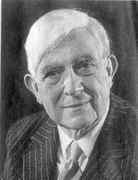Person: Sneddon, Ian Naismith

Ian Sneddon was the Simson Professor of Mathematics at the University of Glasgow and worked on partial differential equations.
Mathematical Profile (Excerpt):
- Ian was brought up in a loving, caring, but poor, home.
- Ian attended Thornwood Primary School from where, at the age of 10, he was successful in competing for a place at the newly opened Hyndland Secondary School in Glasgow.
- This school provided Ian with an outstanding education in the full range of subjects and at age 15 he became Dux of the school.
- After graduating from Glasgow, Sneddon was awarded a Bryce Fellowship which allowed him continue his studies at Trinity College, Cambridge.
- War work often meant that personnel were moved from place to place and soon Sneddon was transferred to work at Fort Halstead in Kent.
- When the war ended Sneddon was appointed to a research post in the H H Wills Physical Laboratory at Bristol University where he continued to work with Mott on nuclear physics and also on their book on wave mechanics.
- Wave Mechanics and its Applications was published in 1948 with Mott and Sneddon as joint authors.
- Before the book was published Sneddon had returned to Glasgow as a lecturer in physics, or rather natural philosophy as the subject was called in the ancient Scottish Universities at that time.
- Although in the physics department, Sneddon continued to be interested in applied mathematics.
- Remarkably the book was reprinted from the 1951 original in 1995, showing what a classic text Sneddon wrote.
- The book concludes with chapters which bring together many results from Sneddon's own papers on boundary value problems in elasticity.
- Before the book appeared in print Sneddon had left Glasgow to take up the chair of mathematics at the University College of North Staffordshire (which later became Keele University).
- He enjoyed the challenge of building up a department in a new institution and now in a department of mathematics Sneddon made the small shift in attitude required to be an applied mathematician rather than a theoretical physicist.
- Each of Sneddon's previous two moves had preceded the publication of a major work by him and Sneddon's final move back to the University of Glasgow in 1956 followed a similar pattern.
- Glasgow established the Simson Chair of Mathematics to which Sneddon was appointed.
- Sneddon's next text Elements of partial differential equations appeared the following year in 1957.
- It was written with exactly the same basic philosophy as all Sneddon's previous books.
- In 1960 Sneddon published a joint text with J G Defares, An introduction to the mathematics of medicine and biology.
- The applications considered in this text are at the forefront of research interests today and show how forward thinking Sneddon was in areas to which to apply his powerful mathematical methods.
- In 1969 Sneddon published Crack problems in the classical theory of elasticity with M Lowengrub.
- Written on a topic on which Sneddon published many papers, it was a comprehensive account of the mathematical analysis of the theoretical distribution of stresses induced in perfectly elastic bodies by the presence of cracks.
- Another major contribution by Sneddon was his work editing Russian translations of major texts.
- By some sort of symmetry many of Sneddon's texts were translated into Russian.
- Sneddon travelled widely, particularly in North America where he held a number of visiting professorships, but he also made visits to Poland, Russia, Italy and Australia.
- Other than mathematics Sneddon's main love was music and the arts in Scotland.
Born 8 December 1919, Glasgow, Scotland. Died 4 November 2000, Glasgow, Scotland.
View full biography at MacTutor
Tags relevant for this person:
Origin Scotland
Thank you to the contributors under CC BY-SA 4.0! 

- Github:
-

- non-Github:
- @J-J-O'Connor
- @E-F-Robertson
References
Adapted from other CC BY-SA 4.0 Sources:
- O’Connor, John J; Robertson, Edmund F: MacTutor History of Mathematics Archive
